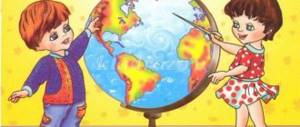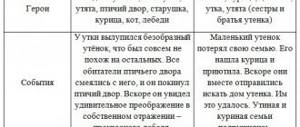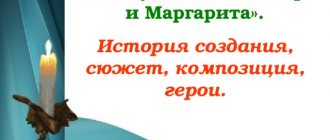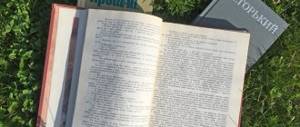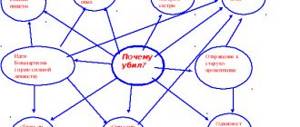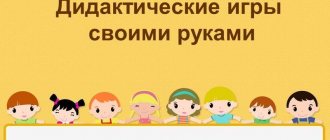Literature quest game for grades 5-8
Extracurricular activity
Quest “Through the Pages of Books”
For students in grades 6-8
Goal: to develop curiosity and interest in reading books; enrich students' vocabulary; to cultivate an attentive reader and love of books, the ability to work in a team.
The game is designed for students in grades 6-8. High school students act as “station guards”. Students receive an advanced task: prepare a team name, motto, emblem corresponding to the theme of the event; reread the fairy tales of A.S. Pushkin, the fables of I.A. Krylov
Equipment: route sheet for each team, puzzle, things for the Lost and Found (you can use photos of things).
A route sheet (made in the form of a map with stations marked on it) is issued to each team, taking into account the fact that they should not intersect at the same station - the game is played simultaneously for all teams. In preparation for the event, it is necessary to make illustration puzzles, letter puzzles, select items for the Lost and Found Office, and think over the design of all stations.
Stations can be located in different parts of the school: in literature rooms, in the gym, in the music room, in the assembly hall. The goal of each team is to guess the name of the book in which the winners will receive a letter from a literary hero. For correctly completing a task at stations, teams receive a number (coded letter). The unraveled letters should form the title of the book. (in our version it is “Robinson Crusoe D. Defoe”)
Time spent at stations is limited - 5 minutes.
PROGRESS OF THE GAME
Presentation of teams (name, motto. For example, “Wings” - “If you read a lot, you gain wings in life!”, “Sorcerers” - “As soon as we wave our wand, we will immediately find the answer to everything”)
The captains are given route sheets.
- station "Zagadochnaya"
At least not a hat, but with a brim, Not a flower, but with a spine. Talks to us in a language everyone understands. (Book)
You are familiar with the expressions: About the first pancake, which is always lumpy, About rubbish, which is carried out of the hut... What do people call them? (Proverbs)
White field, Black seed, He who sows it rejoices. (Letter)
I carry a new house in my hand, The doors of the house are locked. The residents here are made of paper, everyone is terribly important. (Briefcase, books, notebooks)
A short phrase where the sounds are similar. We often cannot say it. Trains us on diction, sometimes with rhyme. What is the name of? Who can guess? (Patter)
STATION 2.
Fold the PUZZLES
(puzzle “The Adventure of Pinocchio” by A.N. Tolstoy).
STATION 3.
Blitz tournament. The team answers questions about the fairy tales of A. S. PUSHKIN
- How many years did the old man fish? (thirty years and three years)
- Who did King Dadon turn to with a request for help? (To the Golden Cockerel)
- For what pay did Balda agree to work for the priest? (in 3 clicks)
- How many times did the old man throw the net before he caught the goldfish? (3 times)
- On what island did Guidon, the son of Tsar Saltan, build his palace? (on Buyan Island)
- What miracles did Prince Guidon have on the wonderful island? (miracle squirrel, 33 heroes, swan princess)
- Who did Prince Elisha turn to with a request for help? (sun, month, wind)
- Who did Tsar Guidon turn into in order to see his father, Tsar Saltan? (Mosquito, fly, bumblebee)
- What words did the queen address to the mirror in “The Tale of the Dead Princess and the Seven Knights”? (“My light, little mirror! Tell me, tell me the whole truth: Am I the sweetest in the world, the most ruddy and whiter of all?..”)
- What wishes did the old woman have in “The Tale of the Fisherman and the Fish”? (- new trough - new hut - to be a pillar noblewoman - to be a free queen - to be the mistress of the sea)
STATION 4.
FABLES.
Continue the famous lines from the fables of I.A. KRYLOV.
- And Vaska listens... (and eats)
- The cuckoo praises the rooster... (Because he praises the cuckoo)
- Did you sing everything? This is the thing... (So go and dance!)
- Ay, Moska, know... (she is strong, since she barks at an elephant)
- And in response to Lisitsyn’s friendly words, the Crow croaked at the top of her lungs.. (The cheese fell out - such was the trick with it)
- The monkey here, out of frustration and sadness, grabbed them like a stone. . (The splashes just sparkled.)
STATION 5.
LOST AND FOUND.
Which literary heroes lost these things? Name the author and title of the fairy tale.
- The Crystal Slipper (Cinderella, H.H. Andersen “Cinderella”).
- Little Red Riding Hood (Little Red Riding Hood, the fairy tale of the same name by Charles Perrault)
- Pea (H.H. Andersen “The Princess and the Pea”)
- Broom (Joan Rolling. Harry Potter)
- Apple (stepmother, A.S. Pushkin. “The Tale of the Dead Princess”)
STATION 6.
Letter PUZZLES.
Make up the name of a work of art from the letters. State the author's name.
RUSLAN AND LYUDMILA (PUSHKIN)
STATION 7.
NUMBERS in literature.
Name works of art whose titles contain numbers.
For each answer 1 point. For an incomplete answer - 0.5 points.
For example, the fairy tale “The Three Little Pigs”, the books by J. Verne “40 Leagues Under the Sea”, “80 Days Around the World”, A. Dumas “The Three Musketeers”.
After passing the stations, the teams finish near the library. The final test awaits them at the entrance.
- It is necessary to answer the question: What famous works of Russian literature are titled with dog names? Name the authors of these works. (“Mumu” by I.S. Turgenev, “Kashtanka” by A.P. Chekhov, “White Bim, Black Ear” by Gavriil Troepolsky, “Bite” by L. Andreev).
- You need to be able to correctly decipher the title of the book in which the message is hidden.
ROBINSON CRUSOE
Next, the team finds a book and a message in it, and reads it.
An awards ceremony is taking place.
Route sheet No. 1
| Station no. | Mysterious | Puzzle illustration | Tales of A.S. Pushkin | Fables | Lost and found | Letter puzzles | Numbers in literature |
| Cipher number |
Route sheet No. 2
| Station no. | Puzzle illustration | Tales of A.S. Pushkin | Fables | Lost and found | Letter puzzles | Numbers in literature | Mysterious |
| Cipher number |
Route sheet No. 3
| Station no. | Tales of A.S. Pushkin | Fables | Lost and found | Letter puzzles | Numbers in literature | Mysterious | Puzzle illustration |
| Cipher number |
Route sheet No. 4
| Station no. | Fables | Lost and found | Letter puzzles | Numbers in literature | Mysterious | Puzzle illustration | Tales of A.S. Pushkin |
| Cipher number |
Cipher letters
| 18 | 2 | 15 | 9 | 12 | 16 | 21 | 10 |
Message option
Tickets on literature (grade 5) material on literature (grade 5) on the topic
Ticket No. 1
1. Define the terms: ballad, dialogue, genre.
2. What genre of fairy tales does “The Frog Princess” belong to? What features of a folk tale can you find in it? Who are the main characters? Why is the fairy tale called this, although the Frog Princess is not the only heroine of the fairy tale?
3. Read by heart any fable by I. A. Krylov.
Ticket number 2
1. Define the terms: plot, rhyme, epithet.
2. How do you explain the title of the fairy tale “Ivan the Peasant Son and the Miracle Yudo”? What character traits of Ivan are revealed before the battle, during the battle and after it?
3. Read by heart “Borodino” by M. Yu. Lermontov (excerpt).
Ticket number 3
1. Define the terms: pseudonym, fairy tale, theme.
2. What is the difference between fairy tales, everyday tales and tales about animals? Explain using examples from fairy tales you have read.
3. Read by heart “I left my home...” by S. A. Yesenin.
Ticket number 4
1. Define the terms: story, stanza, iambic.
2. To which of the three types of fairy tales could V. A. Zhukovsky’s fairy tale “The Sleeping Princess” be classified if it were a Russian folk tale? Justify your answer.
3. Read by heart “I remember - a long winter evening...” by I. A. Bunin.
Ticket number 5
1. Define the terms: portrait, plot, trochee.
2. What did the queen in “The Tale of the Dead Princess” by A. S. Pushkin seek from the mirror and why does Pushkin call her differently: queen, woman, angry queen, evil queen, evil stepmother? Which of these names fully reflects the reason for her unkind attitude towards the princess? Does the new queen look like the first queen, the princess’s mother?
3. Read by heart “The Tankman’s Tale” by A. T. Tvardovsky (excerpt).
Ticket number 6
1. Define the terms: fable, plot, personification.
2. Does Alyosha from “The Black Hen...” by A. Pogorelsky look like the heroes of fairy tales? Is he a positive hero or a negative one? Are there such heroes in folk tales?
3. Read by heart any fable by I. A. Krylov.
Ticket number 7
1. Define the terms: metaphor, description, poem.
2. Who is the main character of N.V. Gogol’s story “The Enchanted Place”? Which of the events in the story would you classify as real and which as fantastic?
3. Read by heart “Borodino” by M. Yu. Lermontov (excerpt).
Ticket number 8
1. Define the terms: proverb, comparison, theme.
2. The image of the lady in “Mumu” by I. S. Turgenev.
3. Read by heart “I left my home...” by S. A. Yesenin.
Ticket number 9
1. Define the terms: idea, composition, folklore.
2. The image of Gerasim in “Mumu” by I. S. Turgenev.
3. Read by heart “I remember - a long winter evening...” by I. A. Bunin.
Ticket number 10
1. Define the terms: climax, personification, story.
2. Why is I. S. Turgenev’s story called “Mumu”?
3. Read by heart “The Tankman’s Tale” by A. T. Tvardovsky (excerpt).
Ticket number 11
1. Define the terms: plot, epigraph, iambic.
2. Tell us about Zhilin’s two escapes from captivity. Why was one of them successful and the other not?
3. Read by heart any fable by I. A. Krylov.
Ticket number 12
1. Define the terms: metaphor, landscape, theme.
2. Dina’s role in the history of Zilina.
3. Read by heart “Borodino” by M. Yu. Lermontov (excerpt).
Ticket number 13
1. Define the terms: personification, fairy tale, trochee.
2. Images of Zhilin and Kostylin.
3. Read by heart “I left my home...” by S. A. Yesenin.
Ticket number 14
1. Define the terms: idea, monologue, portrait.
2. What are the features of humor in A.P. Chekhov’s story “Surgery”? Why do we not only want to laugh, but also feel sad?
3. Read by heart “I remember - a long winter evening...” by I. A. Bunin.
Ticket number 15
1. Define the terms: ballad, comparison, story.
2. The image of Vasya from the work “In Bad Society”? How did his character change after meeting the “children of the dungeon”?
3. Read by heart “The Tankman’s Tale” by A. T. Tvardovsky (excerpt).
Ticket number 16
1. Define the terms: dialogue, genre, means of artistic expression.
2. Why does Tyburtsy say to Vasya: “Maybe it’s good that your road ran through ours”? How do you understand the expression “Vasya’s road to truth”?
3. Read by heart any fable by I. A. Krylov.
Ticket number 17
1. Define the terms: composition, story, epigraph.
2. The image of Filka in the fairy tale “Warm Bread” by K. G. Paustovsky. What was his nickname and why?
3. Read by heart “Borodino” by M. Yu. Lermontov (excerpt).
Ticket number 18
1. Define the terms: fable, personification, story.
2. Explain the meaning of the title of the story by K. G. Paustovsky “Hare Paws”.
3. Read by heart “I left my home...” by S. A. Yesenin.
Ticket number 19
1. Define the terms: climax, metaphor, pseudonym.
2. What are the similarities between S. Ya. Marshak’s tale “The Twelve Months” and a folk tale? What features does it have from a literary fairy tale?
3. Read by heart “I remember - a long winter evening...” by I. A. Bunin.
Ticket number 20
1. Define the terms: denouement, rhyme, plot.
2. Why did Nikita from the story of the same name by A. Platonov try to turn people into inanimate objects? When did he animate everything around? Are the events described in the story real or fantastic?
3. Read by heart “The Tankman’s Tale” by A. T. Tvardovsky (excerpt).
Ticket number 21
1. Define the terms: fairy tale, theme, epigraph.
2. The image of Vasyutka from the work of V. P. Astafiev “Vasyutkino Lake”.
3. Read by heart any fable by I. A. Krylov.
Ticket number 22
1. Define the terms: plot, tragedy, folklore.
2. Why is Sasha Cherny’s story called the same as the work of L.N. Tolstoy – “Prisoner of the Caucasus”?
3. Read by heart “Borodino” by M. Yu. Lermontov (excerpt).
Ticket number 23
1. Define the terms: fable, stanza, epithet.
2. The image of Robinson Crusoe.
3. Read by heart “I left my home...” by S. A. Yesenin.
Ticket number 24
1. Define the terms: dialogue, rhythm, work of art.
2. Which of the heroes of literary works could you give the common name “Robinson”?
3. Read by heart “I remember - a long winter evening...” by I. A. Bunin.
Ticket number 25
1. Define the terms: genre, climax, poem.
2. The image of Gerda in “The Snow Queen”. What is the inner beauty of the heroine?
3. Read by heart “The Tankman’s Tale” by A. T. Tvardovsky (excerpt).
Ticket number 26
1. Define the terms: metaphor, description, story.
2. Tell us about the main characters of the fairy tale “The Snow Queen”, highlighting the key features in their characters.
3. Read by heart any fable by I. A. Krylov.
Ticket number 27
1. Define the terms: fable, theme, epithet.
2. The image of Kish in “The Tale of Kish” by J. London.
3. Read by heart “Borodino” by M. Yu. Lermontov (excerpt).
Lucky ticket (oral answer)
1. Name your favorite piece.
2. Which literary character do you want to be like?
3. Read your favorite poem (any).
